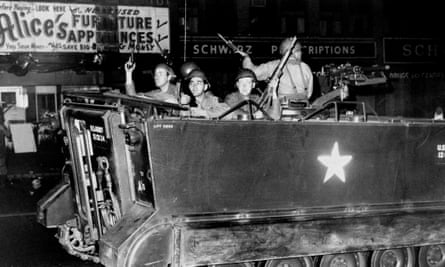DOS_patos
Unverified Legion of Trill member

On 12 July 1967, a man named John Smith steered his taxi around a double-parked police car on a Newark street. It was a hot Wednesday in the Central Ward – the principal black neighbourhood of New Jersey’s biggest city. The cops took offence at Smith’s manoeuvre. They stopped him, pulled him from his cab, and beat him. Then they took him to the Fourth Precinct, and beat him some more.
Smith was black; the cops were white. The Great Migration and white flight to the suburbs had flipped Newark’s demographics, turning it majority-black by the early 1960s. The power structure, however, was still controlled by the old machine. The police force was almost all white. Brutality was the norm. “People had been getting the crap beaten out of them for years,” says community activist Richard Cammarieri, who grew up in one of the Central Ward’s remaining white families. A change was due.
A crowd formed at the precinct, opposite the Hayes Homes, a 13-storey public housing block built in the 1950s but slipping into disrepair. The doctrine of urban renewal, fuelled by federal dollars, had planted a forest of projects – Scudder Homes, Stella Wright Homes, Columbus Homes – so dense that it earned Newark a nickname: Brick City. Now the state wanted to build a medical school on 120 acres of the Central Ward. Many suspected it was part of a plan to drive away black residents.
Activists tried to calm the scene and organise a picket line, maybe a march to City Hall. A rumour spread that Smith was dead. “This time, the angry crowd didn’t go away,” writes activist Junius Williams, who was a Yale law student at the time, spending summers in Newark providing legal services. “This time, they didn’t listen to the leaders who urged non-violence.” Someone threw a firebomb. The Newark riots had begun.

Amina Baraka insists that she did not expect the rebellion. In July 1967, the artist and poet was a young mother with two children from her first marriage and a newborn with her new husband, the poet and playwright Amiri Baraka. They had not yet taken new names: she was still Sylvia Robinson and he, LeRoi Jones. He had moved from New York City to Newark, where they both grew up, to be with her.
“I was interested in visual arts,” Baraka says, in her home in the South Ward, full of art, books, records, and photos of Amiri, who died in 2014. She had known about uprisings in other cities, but didn’t make the connection. “Yeah, it surprised me. It shouldn’t have.”
In fact, the Watts uprising in Los Angeles, in August 1965, had started as Newark’s would, with a traffic stop. That confrontation lasted six days, with 45 deaths, and much looting and destruction. The next year saw trouble in Cleveland and Omaha, among other cities. The details differed but the general picture was the same: a black community packed into substandard housing, excluded from power, abused by police, and no longer willing to bottle its frustration. The response followed a similar pattern too, with authorities quick to send in the National Guard, which tended to escalate, not pacify, the situation.
Newark was under pressure. The city was an early industrial centre – a hub for leather, ironworks, brewing, manufacturing. But it peaked early, and the Depression hit hard. Prohibition boosted organised crime. The population hit 450,000 in 1948, then ebbed as whites, who could get mortgages, moved to the suburbs. Twenty thousand manufacturing jobs disappeared between 1950 and 1967. By then, many waves of black migrants had come from the segregated South. Despite the shrinking industrial base, there were other opportunities in the emerging service economy.

Amina Baraka in her home in Newark: ‘[The rebellion] surprised me. It shouldn’t have.’ Photograph: Siddhartha Mitter
Black Newark clustered in the Central Ward, herded by discriminatory real-estate practices into tenements and, later, the housing projects. The suburbs were out of bounds, but as white families left, some black families moved to the South Ward, which had long been Jewish – home of Philip Roth, among others – and the West Ward. The North Ward was Italian; the East Ward, across the tracks from the rest of the city, was increasingly Portuguese. To the south and east, the seaport and airport were formally part of Newark but run by the Port Authority of New York and New Jersey, and they might as well have been another country.
Springfield Avenue, which traversed the Central Ward, was Black Newark’s high street. “There were bridal shops, musical stores, pawn shops … it was a community,” Baraka says. “A thriving city.” Churches proliferated; so did bars and restaurants, nurturing a thriving jazz scene. There was a red-light district too, on Broome Street.

